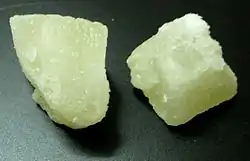Petha
Petha (Hindi: पेठा pronounced [ˈpeːʈʰa]) is a translucent soft candy from Indian subcontinent made from ash gourds (also known as winter melon or white pumpkin, or simply petha in Hindi and Urdu).[1][2]
 | |
| Course | Dessert |
|---|---|
| Place of origin | Indian subcontinent |
| Region or state | India, Sri Lanka, Pakistan |
| Associated national cuisine | Indian cuisine |
| Invented | uncertain |
| Main ingredients | Ash gourd, sugar |
| Variations | Kesar Petha, Angoori Petha, Dry Petha, Chocolate Petha, Paan Petha, Gulab Petha |
| ~250 kcal | |
Preparation
Peta is generally made by cutting ash gourd into cubes, soaking in lime, boiling, and coating in a flavoured sugar syrup.[3]
With growing demand and innovation, more varieties of the original preparation are available. Many flavoured variants are available, e.g. kesar petha, angoori petha etc. There are some other variations based on content, one with coconut mixed, another with some nuts put into it. Sometimes kewda essence is used to flavour petha.[4][5]
History
The Petha is said to have been in subcontinent in various names like Oal and Oal ka Murabba in places like modern day Uttarakhand, Jharkhand and Bihar, There is a legend that says that it originated in Mughal kitchens under Shah Jahan and was used to feed the workers constructing the Taj Mahal but it's highly unlikely considering that there are no mentions of Petha in cookbooks of Shah Jahan like Nuskha-e-Shahjahani also there are mentions of dishes resembling Petha before Mughals came to subcontinent not to mention it isn't like a typical Mughal sweet and Dishes which were rich in Milk and Mawa [6][2][5]
See also
References
- T. R. Gopalakrishnan Vegetable Crops, p. 138, at Google Books
- Sharma, Sudhirendar (12 October 2019). "Name, place, confection, thing". The Hindu. ISSN 0971-751X. Retrieved 28 October 2020.
- "Petha Recipe | How to Make Petha | Agra Ka Petha". NDTV Food. Retrieved 28 October 2020.
- Ammas cooking Archived 2013-05-26 at the Wayback Machine
- "Food Secrets: The Sweet Stories Behind The Legendary Agra Petha and Mysore Pak". The Better India. 2 February 2018. Retrieved 28 October 2020.
- Daftuar, Swati (9 June 2012). "Food Safari: in search of Agra Petha". The Hindu. Retrieved 30 June 2015.
- Mishra, Ishita (31 August 2014). "Petha industry not harming Taj: Kalraj". Times of India. Agra. Retrieved 29 June 2015.